 |
Washington DC (SPX) Jun 16, 2010 The Naval Research Laboratory's (NRL's) Space Science Division is performing an intensive study of the Earth's upper atmosphere using a flotilla of NRL-built spaceflight experiments aboard four concurrent spaceflight missions, involving five satellites and the International Space Station. These coordinated observations utilize both in situ and remote sensors to measure the composition, temperature, and density of the thermosphere and the electron density of the ionosphere, with the objective of understanding the influence of the lower thermosphere upon ionospheric structure and morphology. The joint Taiwan-US COSMIC/FORMOSAT3 mission, a constellation of six micro-satellites, was launched from Vandenberg Air Force Base in April 2006. The NRL Space Science Division designed and built the Tiny Ionospheric Photometer (TIP) compact far-ultraviolet (FUV) sensors, which are being used onboard COSMIC to study the Earth's nighttime ionosphere. The TIP photometers are among the highest sensitivity FUV airglow sensors ever flown. COSMIC is breaking new ground in the study of the Earth's ionosphere, especially in the areas of troposphere-ionosphere coupling and improved global specification of the ionosphere. Currently, TIP sensors aboard two COSMIC spacecraft are gathering ionospheric data for this study. The Remote Atmospheric and Ionospheric Detection System (RAIDS) includes eight spectrographs, spectrometers, and photometers to comprehensively measure thermospheric and ionospheric airglow in the extreme-ultraviolet to near-infrared passband (55 to 874 nm). The extant hardware, built jointly by NRL and The Aerospace Corporation, was adapted for operation on the Japanese Experiment Module Exposed Facility (JEM-EF) aboard the International Space Station (ISS). RAIDS was launched through the DoD Space Test Program on September 10, 2009, aboard the maiden flight of the Japanese Aerospace Exploration Agency H-II Transfer Vehicle and reached the ISS on September 17, 2009 where it was attached to the JEM-EF. RAIDS has been performing science operations since October 23, 2009, collecting temperature data around the globe in the 100 to 200 km altitude range, an altitude region with a paucity of previous temperature measurements. Launched from Vandenberg Air Force Base, Calif., aboard an United Launch Alliance Atlas V launch vehicle, October 18, 2009, the Special Sensor Ultraviolet Limb Imager (SSULI) developed by NRL's Space Science Division and Spacecraft Engineering Department offers a first of its kind technique for remote sensing of the ionosphere and thermosphere from space. Flying on-orbit the U.S. Air Force Defense Meteorological Satellite Program (DMSP) flight 18 satellite, SSULI's characterization of the Earth's upper atmosphere and ionosphere provide the necessary scientific data to support military and civil systems. Offering global observations that yield near real-time altitude profiles of the ionosphere and neutral atmosphere over an extended period of time, SSULI makes measurements from the extreme ultraviolet (EUV) to the far ultraviolet (FUV) over the wavelength range of 80 nanometers (nm) to 170 nm with 2.4 nm resolution. In the category of in situ sensors, NRL developed the Atmospheric Neutral Drag Experiment (ANDE), which was deployed by NASA's Space Shuttle Endeavour in July 2009. The suite consists of two spherical spacecraft, Castor and Pollux, fitted with retro-reflectors for satellite laser ranging. Castor carries instrumentation developed by NRL, NASA/GSFC, and the U.S. Air Force Academy to measure the in situ upper atmosphere density, composition and winds. The datasets retrieved will be applied to improving the current atmospheric density and wind models such as the NRL Mass Spectrometer and Incoherent Scatter-Radar (MSIS) model. The ANDE satellites, orbiting beneath the ISS, provide important validation of the RAIDS density measurements made in the same orbital plane. This combined data set from multiple space vehicles in a variety of orbits and heterogeneous sensing techniques provides excellent spatial, temporal, and spectral coverage for atmospheric and ionospheric characterization. Space Science Division scientists are applying this data to study the relationship between atmospheric dynamics and ionosphere morphology, to understand the influence of solar variability upon chemistry and thermal balance, and to develop next-generation remote sensing approaches to provide high-quality atmospheric specifications to future DoD global atmospheric models.
Share This Article With Planet Earth
Related Links Naval Research Laboratory (NRL) Space Technology News - Applications and Research
 Integral Systems Awarded Contract To Support LS1300
Integral Systems Awarded Contract To Support LS1300Columbia MD (SPX) Jun 09, 2010 Integral Systems has been awarded a follow-on contract from a leading SATCOM service provider to support the addition of a new geostationary communications satellite into their existing EPOCH Integrated Product Suite (IPS) fleet control system. EPOCH IPS provides satellite operators around the world with a single, consolidated management solution for their satellite control needs. The new ... read more |
|
| The content herein, unless otherwise known to be public domain, are Copyright 1995-2010 - SpaceDaily. AFP and UPI Wire Stories are copyright Agence France-Presse and United Press International. ESA Portal Reports are copyright European Space Agency. All NASA sourced material is public domain. Additional copyrights may apply in whole or part to other bona fide parties. Advertising does not imply endorsement,agreement or approval of any opinions, statements or information provided by SpaceDaily on any Web page published or hosted by SpaceDaily. Privacy Statement |